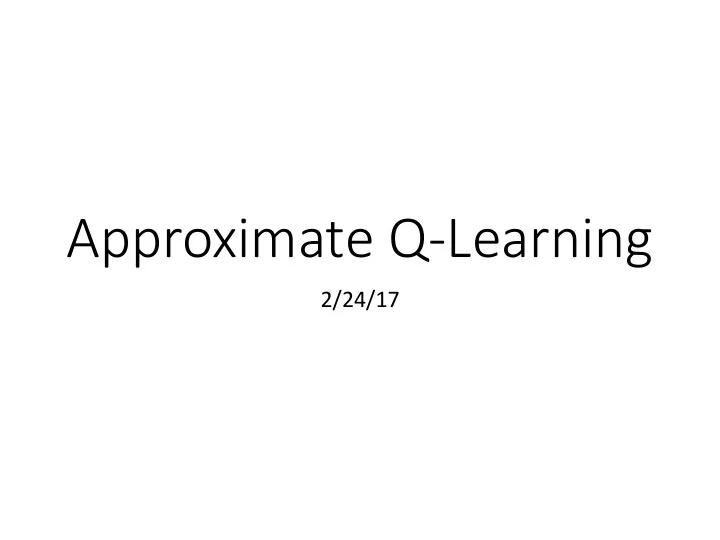

Approximate Q-Learning 2/24/17
State Value V(s) vs. Action Value Q(s,a) " ∞ # X γ t r t V = E t =0 Either way, value is the sum of future discounted rewards (assuming the agent behaves optimally): • V(s) : after being in state s • Value Iteration • Q(s,a) : after being in state s and taking action a • Q-Learning
State Value vs. Action Value • These concepts are closely tied. • Both algorithms implicitly compute the other value. Value Iteration update: P ( s 0 | s, a ) V ( s 0 ) X V ( s ) ← R ( s ) + γ max a s 0 Q-Learning update: h h ii a 0 Q ( s 0 , a 0 ) Q ( s, a ) ← α R ( s ) + γ max + (1 − α ) Q ( s, a )
Converting Between V(s) and Q(s,a) If you know V(s) and the transition probabilities, you can calculate Q(s,a) by taking an expected value: P ( s 0 | s, a ) V ( s 0 ) X Q ( s, a ) = s 0 If you know Q(s,a) , you can calculate V(s) directly by taking a max: V ( s ) = max Q ( s, a ) a
On-Policy Learning (SARSA) Instead of updating based on the best action from the next state, update based on the action your current policy actually takes from the next state. SARSA update: When would this be better or worse than Q-learning?
Demo: Q-learning vs SARSA https://studywolf.wordpress.com/2013/07/01/reinfo rcement-learning-sarsa-vs-q-learning/
What will Q-learning do here?
Problem: Large State Spaces If the state space is large, several problems arise. • The table of Q-value estimates becomes enormous. • Q-value updates can be slow to propagate. • High-reward states can be hard to find. The state space grows exponentially with the number of relevant features in the environment.
Reward Shaping Idea: give some small intermediate rewards that help the agent learn. • Like a heuristic, this can guide the search in the right direction. • Rewarding novelty can encourage exploration. Disadvantages: • Requires intervention by the designer to add domain- specific knowledge. • If reward/discount are not balanced right, the agent might prefer accumulating the small rewards to actually solving the problem. • Doesn’t reduce the size of the Q-table.
PacMan State Space • PacMan’s location • ~100 possibilities • The ghosts’ locations • ~100 2 possibilities • Locations still containing food. • Enormous number of combinations • Pills remaining • 4 possibilities • Ghost scared timers • ~40 2 possibilities The state space is the cross product of these feature sets. • So there are ~100 3 *4*40 2 *(food configs) states.
Function Approximation Key Idea: learn a value function as a linear combination of features. • For each state encountered, determine its representation in terms of features. • Perform a Q-learning update on each feature. • Value estimate is a sum over the state’s features. This is our first real foray into machine learning. Many methods we see later are related to this idea.
PacMan Features from Lab • "bias" always 1.0 • "#-of-ghosts-1-step-away" the number of ghosts (regardless of whether they are safe or dangerous) that are 1 step away from Pac-Man • "closest-food" the distance in Pac-Man steps to the closest food pellet (does take into account walls that may be in the way) • "eats-food" either 1 or 0 if Pac-Man will eat a pellet of food by taking the given action in the given state
Extract features from neighbor states: • Each of these states has two legal actions. Describe each (s,a) pair in terms of the basic features: • bias • #-of-ghosts-1-step-away • closest-food • eats-food
Approximate Q-Learning Update Initialize weight for each feature to 0. Every time we take an action, perform this update: The Q-value estimate for (s,a) is the weighted sum of its features:
Exercise: Feature Q-Update Reward eating food: discount: .95 +10 learning rate: .3 Reward for losing: -500 • Suppose PacMan takes the up action. • The experienced next state is random, because the ghosts’ movements are random. • Suppose moves right and moves down . Old Feature Values: w bias = 1 w ghosts = -20 w food = 2 w eats = 4
Notes on Approximate Q-Learning • Learns weights for a tiny number of features. • Every feature’s value is update every step. • No longer tracking values for individual (s,a) pairs. • (s,a) value estimates are calculated from features. • The weight update is a form of gradient descent. • We’ve seen this before. • We’re performing a variant of linear regression. • Feature extraction is a type of basis change. • We’ll see these again.
Plusses and Minuses of Approximation + Dramatically reduces the size of the Q-table. + States will share many features. + Allows generalization to unvisited states. + Makes behavior more robust: making similar decisions in similar states. + Handles continuous state spaces! − Requires feature selection (often must be done by hand). − Restricts the accuracy of the learned rewards. − The true reward function may not be linear in the features.
Recommend
More recommend